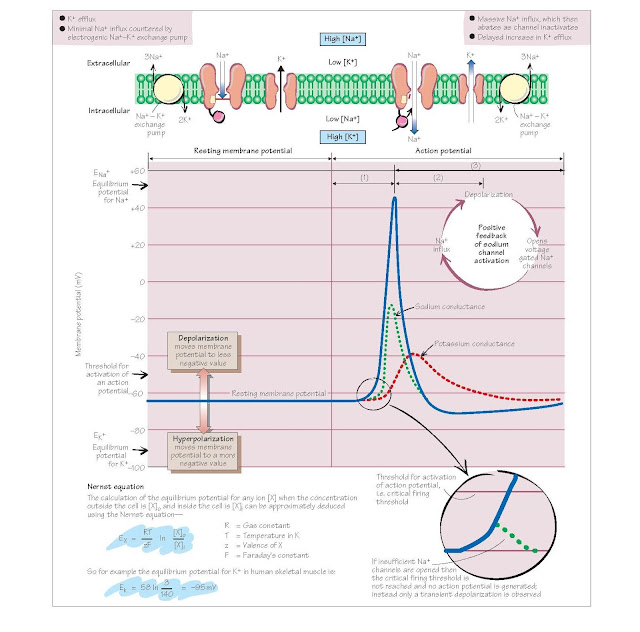Resting Membrane And Action Potential
Resting membrane potential
In the resting state, the neuronal
cell membrane is relatively impermeable to ions. This is important in the
generation of the resting membrane potential.
The major intracellular ion is
potassium, compared to sodium in the extracellular fluid, and so the natural
flow of ions according to their concentration gradients is for K+ to
leave the cell (or efflux) and for Na+ to enter (or influx). The
movement of positive ions out of the cell leads to the generation of a negative
membrane potential or hyperpolarization, while the converse is true for positive
ion influx (a process of depolarization). However, the resting membrane
is relatively impermeable to Na+ ions while being relatively
permeable to K+ ions. At rest therefore, K+ will tend to
efflux from the cell down its concentration gradient, leaving excess negative
charge behind, and this will continue until the chemical concentration gradient
driving K+ out of the cell is exactly offset by the electrical
potential difference generated by this efflux (the membrane potential) drawing
K+ back into the cell.
The membrane potential at which
this steady state is achieved is the equilibrium potential for K+
(Eg + ) and can be
derived using the Nernst equation (see figure for details). In fact, the
measured resting membrane potential in axons is slightly more positive than
expected because there is some small permeability to Na+ of the membrane in the
resting state. The small Na+ influx is countered by an adenosine
triphosphate (ATP) dependent Na+–K+ exchange
pump which is itself slightly electrogenic. This pump is essential in
maintaining the ionic gradients, and is electrogenic by virtue of the fact that
it pumps out three Na+ ions for every two K+ ions brought in. It
makes only a small contribution to the level of the resting membrane potential.
Action potential generation
One of the fundamental features of
the nervous system is its ability to generate and conduct electrical impulses
(see Chapters 17 and 18). These can take the form of generator potentials,
synaptic potentials and action potentials – the latter being defined as a
single electrical impulse passing down an axon.
This action potential (nerve
impulse or spike) is an all-or-nothing phenomenon, that is to say
once the threshold stimulus intensity is reached an action potential will be
generated. Therefore information in the nervous system is coded by frequency of
firing rather than size of the action potential (see Chapter 22). The threshold
stimulus intensity is defined as that value at which the net inward current
(which is largely determined by Na+ ions) is just greater than the net outward
current (which is largely carried by K+ ions), and is typically
around −55 mV (critical firing threshold). This occurs most readily in
the region of the axon hillock where there is the highest density of Na+ channels, and is thus the site
of action potential initiation in
the neurone. However, if the threshold is not reached, the graded
depolarization will not generate an action potential and the signal will not be
propagated along the axon.
Sequence of events in the
generation of an action potential
1. The depolarizing voltage activates the voltage
sensitive Na+ channels in the neuronal membrane, which allows some
Na+ ions to flow down their electrochemical gradient (increased Na+ conductance).
This depolarizes the membrane still further, opening more Na+
channels in a positive feedback loop. When sufficient Na+
channels are opened to produce an inward current greater than that generated by
the K+ efflux, there is rapid opening of all the Na+
channels producing a large influx of Na+ which depolarizes the
membrane towards the equilibrium potential for Na+ (approximately
+55 mV). The spike of the action potential is therefore generated, but fails to
reach the equilibrium potential for Na+ because of the persistent
and increasing K+ efflux.
2. The falling phase of the action potential then
follows as the voltage sensitive Na+ channels become inactivated (see Chapter
14). This inactivation is voltage dependent, in that it is in response to the
depolarizing stimulus, but has slower kinetics than the activation process and
so occurs later (see Chapter 14). During this falling phase, a voltage
dependent K+ current becomes important as its activation by the
depolarization of the membrane has even slower kinetics than sodium channel
inactivation. This voltage activated K+ channel leads to a brief period of
membrane hyper- polarization before it deactivates and the membrane potential
is returned to the resting state.
3. Immediately after the spike of the action
potential there is a refractory period when the neurone is either
inexcitable (absolute refractory period) or only activated to submaximal
responses by suprathreshold stimuli (relative refractory period). The
absolute refractory period occurs at the time of maximal Na+ channel inactivation,
while the relative refractory period occurs at a later time when most of the
Na+ channels have returned to their resting state but the voltage activated K+
current is well developed. The refractory period has two important implications
for action potential generation and conduction. First, action potentials can be
conducted only in one direction, away from the site of its generation and,
secondly, they can be generated only up to certain limiting frequencies (see Chapter 17).





